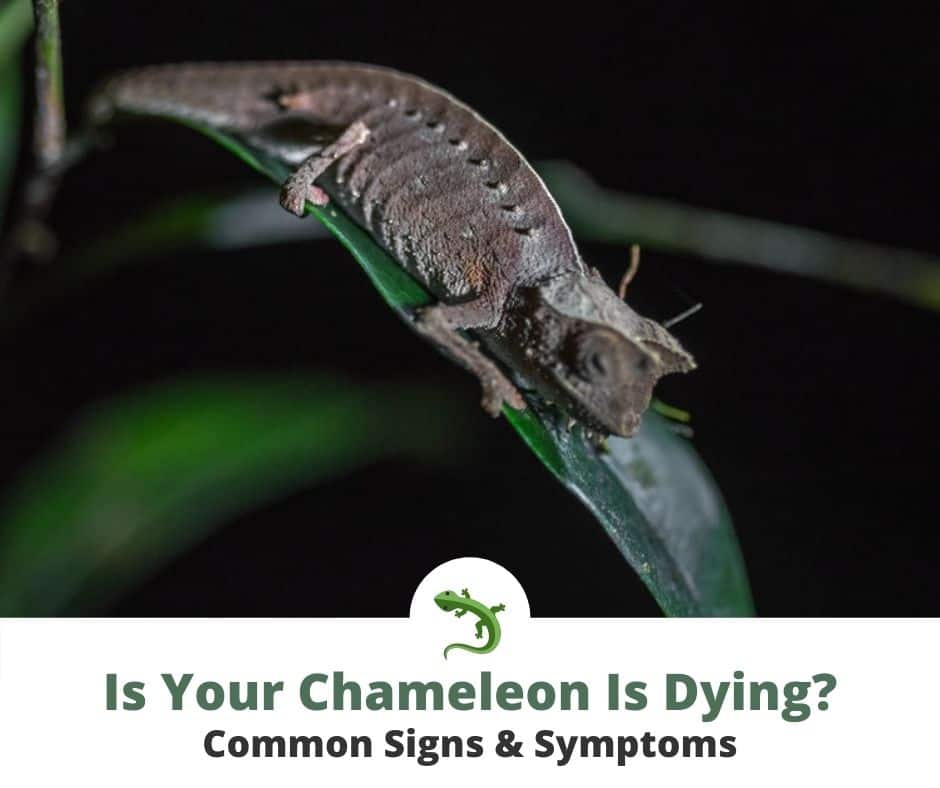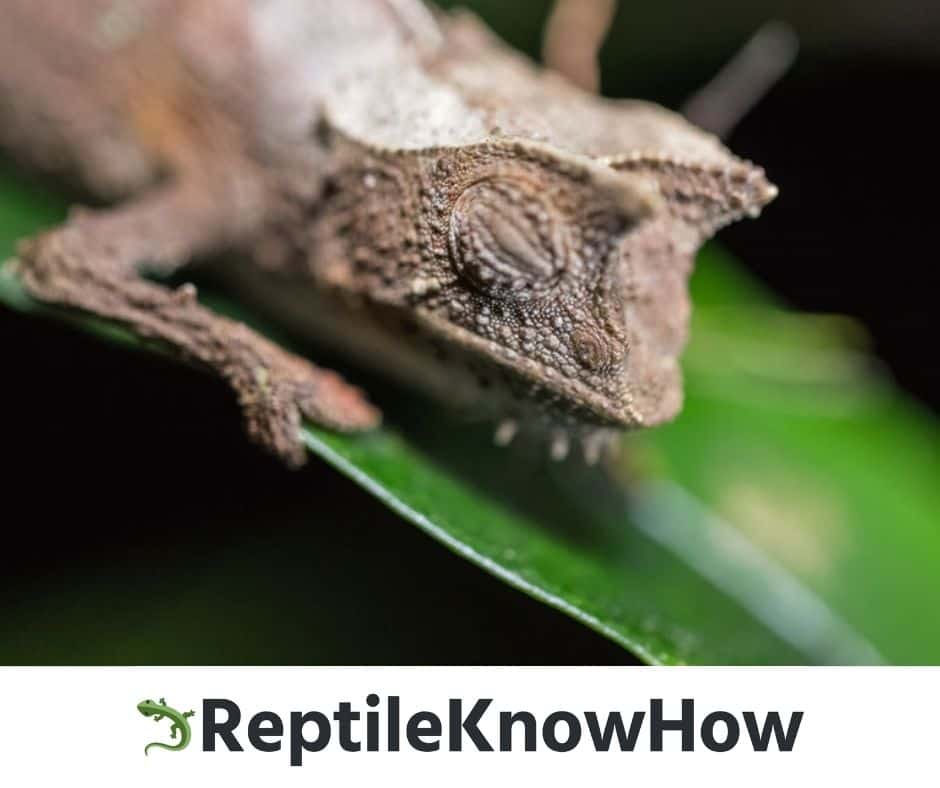If you’re concerned that your chameleon is dying, the first course of action is to seek the help of a Vet. This article will help you understand the possible causes of a dying chameleon.
In this guide, you’ll learn:
- What are the common reasons Chameleons die in captivity?
- What are the early signs of sickness and stress?
- When should you see a Vet?

Common Reasons For A Dying Chameleon
Chameleons are fascinating animals that can be quite challenging to take care of, especially compared to other lizards such as iguanas or bearded dragons. Chameleons are beautiful, solitary, and peaceful animals that have unique habitat requirements in order to live a healthy life in captivity.
This article will cover the most common causes of death for chameleons – dehydration, dietary insufficiencies, parasites, and chronic stress- and shed some light on how to identify and prevent them.
Caution
Chameleons are expert-level reptiles and should only be kept by experienced handlers. We do not recommend them for first-time reptile owners.
Poor or Incorrect Diet
Chameleons are omnivorous lizards with varied diet needs. In the wild, they combine hunting with plants to obtain the nutrients they need.
Mimicking the natural diet of a chameleon while in captivity can be quite a challenge and not doing it properly can lead to health threats for your pet.
If your chameleon is not being fed the way it needs to, it might present behavioral changes such as lethargic states, mucous expel from their mouth and nose and an almost constant lack of energy.
Dehydration
Chameleons are extremely delicate animals who need to live in humid environments. As the mist levels they need are difficult to reproduce in an enclosure, dehydration is the most common cause of death for pet chameleons. Dehydration can be fatal if not treated early, so if you notice unusual behaviors in your pet, discard possible dehydration in order to avoid serious health complications.
Signs Of Dehydration In Chameleons
Dehydration is a condition caused by the loss of too many fluids from the body of your pet. The body does not get enough fluids to work properly, and it might manifest in very different ways in your pet.
The most common symptoms of dehydration are sunken eyes, yellow or orange-colored urates, lethargy, loss of appetite, and loss of flexibility in the skin.
In the early stages of dehydration, your chameleon might not present all the symptoms named above, but early detection of the problem is key to avoid long-term consequences. Make sure the humidity levels in your chameleon’s enclosure meet the needs of your animal and make an appointment with a reptile veterinarian to properly assess the problem.
If your pet is older than 5 months you can also give it a 30 min shower by placing a live plant in the shower plate. Put your chameleon under the plant and direct the showerhead to the wall, so that the water bounces off as mist. Showering will help your dehydrated lizard to slowly recuperate part of the water it lacks.
Stress
Chameleons are also very sensitive to stress and if they live under chronic stress for a long time they will die. Although there are many different kinds of stress, we can categorize them into 4 big groups: temporary stress- as a response to an action delimited in time-, internal and external physical stress, and emotional stress. This categorization responds to the source that is causing your chameleon to experience anxiety, but all the aforementioned types can manifest themselves through the same symptoms.

Signs Of Stress In Chameleons
- The chameleon salute. The chameleon salute consists of your pet bringing its leg close to its chests, sometimes accompanied by slowly recoiling. This movement, usually interpreted by humans as charming and it’s a sign of fear and distress in chameleons.
- Puffing out its gular. Bloating the pouch of skin in the neck area to appear bigger is a sign of stress in chameleons. The gular usually presents bright colors, and they use it to threaten other chameleons and animals. So, even if you are impressed by the brighter coloring of your pet, it might be advising you that it’s going through a stressful moment.
- Flattening its body. Chameleons flatten their body to look bigger and fiercer to potential dangers. However, many other causes can explain this behavior and are not a cause for concern, such as wanting to get more sunlight and camouflaging.
- Gaping– Gaping-maintaining their mouth open- is for chameleons a sign they are about to bite. Chameleons are mainly very calm creatures and unusual aggression and mouth behavior are definitely a sign your animal is experiencing stress.
- Darkening colors: Chameleons use their color spectrum to express their needs, intentions, and emotional states. Presenting darkening colors is normally a sign your chameleon is scared or accepting defeat. If your chameleon is turning darker while it is in another part of its cage, it is a sign that it is scared and decided to take a submissive role. Closing its eyes is a more extreme symptom of the same anxiety.
- Biting. Although under normal circumstances chameleons do not show aggressive traits, they can and will bite if they are under stress. Chameleons have small teeth that can harm you and they will use them to protect themself from an anxious situation. The bite of a chameleon is not dangerous or poisonous, but it is a sign that you should give your pet some space. Biting is normally preceded by other signs, such as hissing, gaping, staring, and changing color.
- Dropping or discing. If your chameleon jumps while you are handling it, it is probably experiencing major stress. It is a sign it doesn’t feel safe or comfortable with you to the point that jumping off to the unknown seems the most viable option. If your chameleon is presenting this type of behavior, you should reevaluate its living situation and give him time to learn to trust you and to feel comfortable in its cage.
- Running away. This one might seem a bit obvious at first, but it is more complex than it looks. Chameleons are animals whose main defense mechanism is to camouflage and disguise. Running away is therefore a very radical choice on their part, which they might be only taking because of an extremely tense situation. So, even if standing still does not mean that your lizard is comfortable, running away is certainly a sign that it is experiencing major distress.
📚 Read More >> What Do A Chameleon’s Colors Mean?
Metabolic Bone Disease (MBD)
Metabolic bone disease is a common cause of death in chameleons. If it is not diagnosed and treated early it will lead to serious health consequences and ultimately death. Metabolic bone disease can present many early symptoms. If your chameleon presents frequent states of lethargy, broken bones, struggles to close its mouth or swollen limbs, it might be affected by metabolic bone disease.
Metabolic bone disease consists of the weakening and deformation of your lizard’s bones caused by a dietary deficiency of calcium and a lack of exposure to UVB radiation. Chameleons need at least 12 hours under a UVB bulb every day to obtain vitamin d to metabolize their calcium intake. Metabolic bone disease often affects young reptiles, although reptiles of all ages can suffer from it. Calcium supplements and vitamins, along with a strong UVB light are always necessary to treat and prevent metabolic bone disease,
Signs of MBD
- Lethargy and weakness- If your lizard has an extremely passive attitude, it might be afflicted with MBD. When they are healthy, chameleons are often peaceful, but alert and receptive to their environment.
- Loss of appetite– as they have difficulties eating, chameleons with metabolic bone disease might refuse to eat or do it less often than they normally would.
- Difficulties closing its mouth: Their jawbones weaken as well, so if you notice your chameleon has difficulties closing its mouth and using its tongue, you need to visit a reptile veterinarian.
- Bent limbs. Chameleons affected with MBD present extremely bent joints. Their articulations and bones are weakened and they have problems grabbing branches and climbing.
Parasitic Infestations
Chameleons often have a mild parasitic presence in their body. This is especially common in wild-caught chameleons or captive-bred from larger collections and it often doesn’t provoke further problems. However, if the health of your chameleon is weakened – by stress, dehydration, or other illnesses- the parasites will multiply and can become a serious threat to your pet’s health.
There are two types of parasites: endoparasites– which live inside the organs of your lizard- and ectoparasites, which live on the chameleon’s skin.
Many types of parasites can attack your chameleon and only a few of them are visible to the naked eye.
Some of the most common endoparasites families for chameleons are coccidia, cryptosporidia, and flagellates. External parasites include mites- which are arachnids that attack the eyes- and ticks which are rarer and easier to treat.
Common symptoms of parasitic infestations are loss of appetite, constipation, a swollen belly, diarrhea, and smelly feces.
If you suspect your animal is suffering from a parasitic infestation, it’s highly recommended you visit a reptile veterinarian to assess the nature of the problem and its possible treatments.
When To See A Vet
Chameleons can be quite complex to read, so if you notice unusual behaviors in your lizard, you should make an appointment at your reptile vet. Problems such as metabolic bone disease and parasites are particularly difficult to diagnose and a diagnosis from a veterinarian will shed some light on your pet’s behaviors.
FAQs
How long do pet chameleons live?
Chameleons in captivity can be extraordinarily long-lived, reaching more than 10 years. In the wild, they normally live around 2 to 4 years.
Gender usually plays a central role in the length of the life of your chameleon, females live on average 3 to 5 years less than males. This is explained by the enormous toll that breeding takes on female chameleons. The reproductive process weakens both temporarily and permanently the body of female chameleons, making them more prone to appearance illnesses during the breeding season and long-term damaging the organs of females.
Male chameleons are larger and more resistant to illnesses than females and will live from 5 to 10 years.
Why do chameleons die so fast?
Chameleons are fascinating animals, but they are certainly high maintenance when kept as pets. Chameleons are intrinsically fragile and are very sensitive to the environment. Chameleons need very specific living conditions and don’t adapt well to new situations. Chameleons are certainly not recommended if for not advanced owners.
Can chameleons play dead?
Yes. Although it’s not very common, chameleons can play dead if they feel threatened. If your chameleon feels it is facing a dangerous situation, it will curl into a fetal position and wait for the threat to disappear.
Playing dead commonly seen in animals who have a low position on the food chain, as pretending to be dead makes them less likely to be eaten or attacked.
What does a sick chameleon look like?
A sick chameleon might present very different appearances depending on the illness that afflict them. Chameleons are distinctive for their colorful and vibrant appearance, so a loss of flexibility and color in the skin is one of the easiest and most typical symptoms of ill chameleons. Other signs that your chameleon might be sick include presenting lethargic or excessively mistrustful behaviour.


